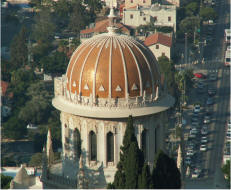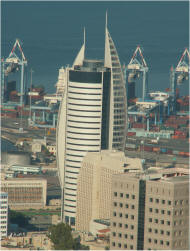Haifa is Israel’s third largest city after Jerusalem and Tel Aviv. Today, Haifa is a thriving and diverse cultural and ethnic center home to Jews, Arabs, Baha’is, Druze and others.
 Its history, however, dates back many, many centuries. The first instance of a settlement with the name Haifa can be found as early as the 3rd century CE.
Its history, however, dates back many, many centuries. The first instance of a settlement with the name Haifa can be found as early as the 3rd century CE.
The ancient Haifa site ran down to the shore, and was centered on a cove in the shoreline several hundred meters south of Rambam hospital.
From the 3rd century, around the cove a settlement developed whose residents engaged in coastal trade, fishing and farming, making use of the plain, which on this section of the contact line of Mount Carmel and the sea attains its greatest width. In the Mishna and the Talmud the settlement is sporadically mentioned. The importance of the town also lay in its proximity to the Mount Carmel and to Elijah’s Cave.
During WWI, Haifa bay was entirely blockaded and mined by the Turks. On 23 September, 1918, the British took control of the city. The most significant contribution of the British Mandate was the construction of the port, which gave an immense boost to the city’s economy. Of the tens of thousands of Jews who reached Eretz Israel in the 1920’s and 1930’s, many opted to settle in Haifa, which then offered a range of occupations and opportunities for building. In those years Arabs (Muslims and Christians) also migrated to Haifa, finding employment in the large enterprises arising in the city and in its workshops. The 1931 census recorded a population of 50,000 in Haifa (31 percent Jews), while in 1944 the figure was 128,000 (52 percent Jews) and Arabs worked side by side in the large factories and in the port, and also in the commercial districts. In 1948, on Passover Eve (21-22 April), Hagana forces gained control of Haifa and caused an historic change in it. Tens of thousands of Arab citizens abandoned their city, and only 3,500 of them, mostly Christians, remained.
 Despite the fact that most left of their own accord, Haifa continues to be a place where Jews and Arabs live side by side. It has long been regarded as a “mixed” city where relations are generally good between Jews and Arabs. Of particular note was the bombing at the Maxim Restaurant on October 2, 2003 in which 21 Israelis – Arabs and Jews – were murdered.
Despite the fact that most left of their own accord, Haifa continues to be a place where Jews and Arabs live side by side. It has long been regarded as a “mixed” city where relations are generally good between Jews and Arabs. Of particular note was the bombing at the Maxim Restaurant on October 2, 2003 in which 21 Israelis – Arabs and Jews – were murdered.
Haifa is home to one of the two oil refineries in Israel (the other located in Ashdod). Matam (Mirkaz Ta’asiya v’Meida/Scientific Industries Center), the largest and oldest business park in Israel, is located at the southern entrance to the city, hosting manufacturing and R&D facilities for a large number of Israeli and international hi-tech companies.
On July 13, 2006, Haifa was the target of rockets fired by Hezbollah terrorists. It was the first time the city was targeted, though in the days that followed, it was hit many times, including an attack on July 16 that left 8 Israelis dead and dozens injured.
